Fibre Computer Enables More Accurate Recognition of Human Activity
Published in Bioengineering & Biotechnology, Materials, and Physics

In a recent study published in Nano-Micro Letters, researchers led by Qianyi Cheng, Prof. Jianfeng Li (Lanzhou Jiaotong University), and Prof. Qichong Zhang (Suzhou Institute of Nano-Tech and Nano-Bionics, CAS) have introduced a groundbreaking “single-fibre computer” that integrates sensing, communication, computation, and storage into a single stretchable, machine-washable fibre. By networking multiple such fibres into a distributed computational textile, they achieved human activity recognition accuracy of 95%—a dramatic leap from the 67% achieved by single-fibre systems.
Why This Research Matters
- All-in-one functionality: Each fibre embeds eight microelectronic devices, including four sensors (photodetector, temperature sensor, PPG, accelerometer), a 32-bit MCU, and dual communication modules (Bluetooth and optical).
- High performance: Multi-fibre cooperative sensing enables accurate, real-time recognition of complex human movements such as squats, planks, lunges, and arm rotations.
- Wearable-friendly design: Over 60% stretchability, machine-washability, and wireless communication remove the constraints of rigid wiring.
Innovative Design and Mechanisms
- 2D-to-3D interposer strategy: Flexible interposers map flat microchip pad layouts into cylindrical fibre architectures, enabling seamless chip integration.
- Helical electrode architecture: Spiral copper wiring maintains electrical integrity under stretching, ensuring durability.
- Dual communication modes: Optical links enable low-latency fibre-to-fibre data transfer, while BLE modules provide long-range wireless networking.
Applications and Future Outlook
- Smart textiles: Enables edge computing directly in fabrics for health monitoring, sports analytics, and human–computer interaction.
- Scalable textile networks: The distributed architecture opens the door to modular, reconfigurable, and intelligent garment systems.
- Next steps: Optimizing communication protocols, reducing power consumption, and integrating advanced distributed learning (e.g., federated learning) could further enhance performance and adaptability.
By merging computation with fabric at the fibre level, this work redefines what wearable electronics can achieve—paving the way for the next generation of intelligent, interactive textiles.
Follow the Topic
-
Nano-Micro Letters

Nano-Micro Letters is a peer-reviewed, international, interdisciplinary and open-access journal that focus on science, experiments, engineering, technologies and applications of nano- or microscale structure and system in physics, chemistry, biology, material science, and pharmacy.






Please sign in or register for FREE
If you are a registered user on Research Communities by Springer Nature, please sign in